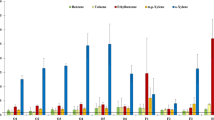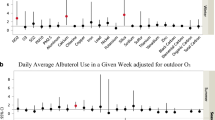Abstract
Objectives
To study the relationship between a high incidence of bronchial asthma among employees working in an office building and an indoor air problem related to the degradation of polyvinyl chloride (PVC) floor coverings in the building. The indoor air measurements and results of renovations are also described.
Methods
Employees’ symptoms were surveyed by a questionnaire, and the incidence of asthma was calculated from the medical records for 1997–2000. The quality of indoor air was assessed by microbial sampling and by investigation of the building for possible moisture damage. Indoor air was sampled for volatile organic compounds (VOCs) through Tenax adsorbent tubes. In situ volatile emission measurements from the concrete floor were performed via the field and laboratory emission cell (FLEC) method.
Results
In an office with approximately 150 employees, eight new cases of asthma were found in 4 years. In addition, the workers complained of respiratory, conjunctival and nasal symptoms. Emissions indicating the degradation of plastic floor coverings (e.g. 2-ethyl-1-hexanol, 1-butanol) were found in the indoor air and floor material samples. The plastic floor coverings, adhesives and the levelling layers were carefully removed from 12 rooms. The VOCs had diffused into the underlying concrete slabs. The concrete was warmed to remove the diffused VOCs from these areas. After the repairs the concentrations of the VOCs indicating the degradation of PVC, decreased, as did the prevalence of the employees’ symptoms and several asthma patients’ need for medication.
Conclusions
The workers in the office building complained of several respiratory, conjunctival and dermal symptoms. The incidence of adult-onset asthma was approximately nine-times higher than that among Finns employed in similar work. The most probable single cause of the indoor air problem was the degradation of the plastic floor coverings.


Similar content being viewed by others
References
Andersen AA (1958) New sampler for collection, sizing and enumeration of viable airborne particles. J Bacteriol 76:471–484
Bornehag CG, Blomquist G, Gyntelberg F, Järvholm B, Malmberg P, Nordvall L, Nielsen A, Pershagen G, Sundell J (2001) Dampness in buildings and health. Nordic interdisciplinary review of the scientific evidence on associations between exposure to “dampness” in buildings and health effects (NORDDAMP). Indoor Air 11:72–86
Gustavsson H, Lundgren B (1997) Off-gassing from building materials: a survey of case studies. In: Brune D, Gerhardsson G, Crockford GW, Dáuria D (eds) The workplace, vol 1. Fundamentals of health, safety and welfare. International Labor Office, Geneva, pp 533–555
Husman T (1996) Health effects of indoor-air microorganisms. Scand J Work Environ Health 22:5–13
Jaakkola JJ, Verkasalo PK, Jaakkola N (2000) Plastic wall materials in the home and respiratory health in young children. Am J Public Health 90:787–789
Karjalainen A, Kurppa K, Martikainen R, Karjalainen J, Klaukka T (2002) Exploration of asthma risk by occupation—extended analysis of an incidence study of the Finnish population. Scand J Work Environ Health 28:49–57
Mizoue T, Reijula K, Andersson K (2001) Environmental tobacco smoke exposure and overtime work as risk factors for sick building syndrome in Japan. Am J Epidemiol 154:803–808
Norbäck D, Wieslander G, Nordström K, Wålinder R (2000) Asthma symptoms in relation to measured building dampness in upper concrete floor construction, and 2-ethyl-1-hexanol in indoor air. Int J Tuberc Lung Dis 4:1016–1025
Pasanen A-L, Korpi J-P, Pasanen P (1998) Critical aspects on the significance of microbial volatile metabolites as indoor air pollutants. Environ Int 24:703–712
Peat JK, Dickerson J, Li J (1998) Effects of damp and mould in the home on respiratory health: a review of the literature. Allergy 53:120–128
Samson A, Flannigan B, Flannigan ME, Verhoeff AP, Adam OCG, Hoekstra ES (1994) Recommendations, health implications of fungi in indoor environments. Air quality monographs, vol 2. Elsevier, Amsterdam
Seppänen O, Säteri J (eds) (2001) Classification of indoor climate 2000. Finnish Society of Indoor Air Quality and Climate, Espoo, Finland
Tuomainen M, Pasanen AL, Tuomainen A, Liesivuori J, Juvonen P (2001) Usefulness of the Finnish Classification of Indoor Climate, Construction and Finishing Materials: comparison of indoor climate between two new blocks of flats in Finland. Atmos Environ 35:305–313
Verhoeff AP, Burge HA (1997) Health risk assessment of fungi in home environments. Ann Allergy Asthma Immunol 78:544–556
Wieslander G, Norbäck D, Nordström K, Wålinder R, Venge P (1999) Nasal and ocular symptoms, tear film stability and biomarkers in nasal lavage, in relation to building-dampness and building design in hospitals. Int Arch Occup Environ Health 72:451–461
Wiglusz R, Igielska B, Sitko E, Nikel G, Jarnuszkiewicz I (1998) Emission of volatile organic compounds (VOCs) from PVC flooring coverings. Bull Inst Marit Trop Med 49:101–107
Acknowledgements
The authors thank Virpi Turunen and Arja Miihkinen for their careful collection of samples, Marjut Reiman and Sirpa Laitinen for the microbial analyses and Pirjo Aholainen for her excellent technical laboratory assistance.
Author information
Authors and Affiliations
Corresponding author
Rights and permissions
About this article
Cite this article
Tuomainen, A., Seuri, M. & Sieppi, A. Indoor air quality and health problems associated with damp floor coverings. Int Arch Occup Environ Health 77, 222–226 (2004). https://doi.org/10.1007/s00420-003-0481-2
Received:
Accepted:
Published:
Issue Date:
DOI: https://doi.org/10.1007/s00420-003-0481-2




